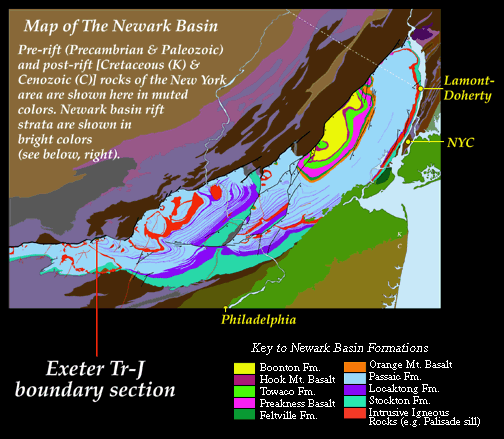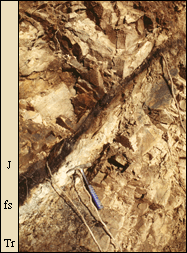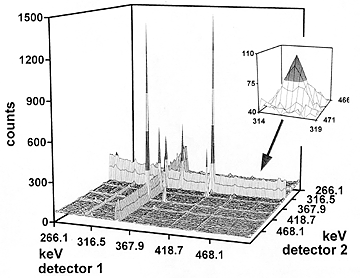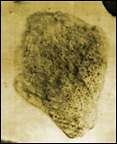PROGRESS IN THE SEARCH FOR AN IMPACT LAYER AT THE
TRIASSIC-JURASSIC BOUNDARY IN EASTERN NORTH AMERICA *
Paul E. Olsen1,
Christian Koeberl2, Heinz Huber2,
and Alessandro Montanari3
1Lamont-Doherty Earth Observatory of Columbia
University, Rt. 9W, Palisades, NY 10964, USA (polsen@ldeo.columbia.edu)
2Institute of Geochemistry, University of
Vienna, Althanstrasse 14, A-1090 Vienna, AUSTRIA (christian.koeberl@univie.ac.at)
3Osservatorio Geologico do Coldigioco, I-62020
Frontale di Apiro, Italy
(sandro.ogc@fastnet.it)
* Presented as a poster session at the LPI conference - "Catastrophic
Events and Mass Extinctions: Impacts and Beyond" at the Geozentrum University
of Vienna, Austria, July 9-12, 2000. This web version has been reformatted
to fit the www format. Abstract available at: http://www.ldeo.columbia.edu/~polsen/nbcp/olsen.dnld.html
INTRODUCTION
The Triassic-Jurassic (Tr-J) boundary marks one of the
"big five" mass extinctions in the last half billion years. The Triassic-Jurassic
boundary has been identified in Eastern North America in lacustrine rift
basin strata of the Newark Supergroup (Fig. 1) by palynological and vertebrate
biostratigraphic comparisons with Europe and elsewhere (Cornet, 1977; Cornet
and Olsen, 1985; Fowell, 1994; Fowell and Olsen, 1993; Fowell et. al.,
1994; Fowell and Traverse, 1995; Olsen, 1977; Olsen and Galton, 1977; Olsen
and Sues, 1986; Olsen et al., 1990, 1991).
| These lacustrine deposits, including the boundary sections,
are profoundly cyclical with the cyclicity being attributed to astronomical
(Milankovitch) forcing of climate (Olsen, 1986; Olsen et al., 1996a; Olsen
and Kent, 1999). Overlying a relatively thin interval of Jurassic age lacustrine
deposits is a basaltic lava flow sequence with more interbedded and overlying
cyclical lacustrine sequences. The lava flows, and more specifically, their
feeder systems, yield 40Ar/39Ar
and U-Pb dates of about 201.5+2 my (Hodych & Dunning 1992, Sutter 1988,
Ratcliffe 1988), an age, geologically indistinguishable from U-Pb dates
from marine, ammonite-bearing, strata (199.6±0.3 Ma; Palfy, 2000).
The Milankovitch cyclostratigraphy of the surrounding sedimentary formations
in the Deerfield, Hartford, Newark, and Culpeper basins is the basis for
the suggests that the entire extrusion sequence lasted no longer than about
600,000 (Olsen et al 1996b). The duration of the this igneous episode is
thus similar to that of other flood basalt provinces such as the Deccan
and Siberian traps (Jaeger et al 1989, Renne and Basu 1991). Thus, far
the boundary has been palynologically identified at a high level of resolution
(< 20 ky) in the Newark and Fundy basins. The Milankovitch cyclostratigraphy
of the surrounding lacustrine sediments suggests that the boundary occurs
less than 40 ky prior to the oldest basalts in these respective basins,
probably about 20 ky. |
 |
Figure 1 (right): A, Pangea during the Late Triassic
showing the position of the rift zone (gray), the Newark Supergroup basins
(black), and the Newark basin (1).
B, Major basins of the Newark Supergroup. Modified from Olsen et al., 1996.
|
| In the Newark basin (Fig. 2, below), the boundary has
been studied lithologically and paleontologically at several sites along
a 1 km strike traverse in the Jacksonwald syncline (including the sections
described here at Exeter), the Martinsville no. 1 core of the Newark Basin
Coring Project, and outcrops near Patterson, and Clifton, New Jersey. |
 |
Figure 2 (right): Map of the Newark Basin showing the distribution
of various lithological units and position of the Exeter section within
the Jacksonwald syncline. Modified from Olsen et al., 1996a.
|
|

|
 |
Figure 3 (above): Triassic-Jurassic boundary in the Jacksonwald
syncline (section I). Boundary (dark line) is at inset, shown in
detail on right. Rocks shown are red and gray mudstones on right and gray
mudstones and sandstones on left. Hill is capped by Orange Mt. Basalt.
|
Figure 4 (above): Detail of Triassic-Jurassic boundary at Section
I. Abbreviations are: J, Jurassic strata; fs, "fern spike"; Tr, Triassic
strata.
|
In the Jacksonwald syncline, close to the border fault system
on the Newark rift basin, the boundary section occurs about 8 to 10 m below
the Orange Mountain Basalt, in the uppermost part of the ~ 3 km thick Passaic
Formation (Fig. 3, above). The boundary sections consists of a predominately
red cyclical lacustrine mudstone sequence that becomes finer grained, and
grayer towards the axis of the basin. A meter-scale sequence of red, gray
and black strata contain the palynological boundary has been exposed by
housing construction at many sites for 2 km along strike (Fig. 4, above).
Sections at four such sites formed the basis of our study. A the three
sections Sections l-111) closer to the axis of the basin, these; sections
consist of a basal gray siltstone and sandstone with roots and a Triassic-type
palynoflora (samples 7-11. 16-19, 25). This is succeeded by a few centimeters
of white to light gray smectite-rich clay and silt (Smith et. al. 1989),
also with roots (samples 3-6, 14-15, 24; ), overlain by 1 to 3 cm of black
carbonaceous shale or coal. The latter two beds contain very high percentages
of (~60-90%) fern spores, comparable to the K-T fern spike (Tschudy et
al., 1984). This is the only coal know in the ~6 km thick Newark basin
section. The black shale or coal is overlain by 0.5 to 1.5 m of gray-blue
sandstone and siltstone with abundant plant fragments and charcoal. To
the west, closer to the boundary fault system, this sequence becomes predominantly
much more red, although the same basic litho- and palynostratigraphy is
recognizable (Section IV site - samples 26-36) samples). Palynological
samples from beds overlying the gray to red charcoal bearing sandstone
on top of the "fern spike" are of typical Jurassic composition, completely
lacking Triassic taxa.
There have been two previous and unsuccessful attempts
to find shocked quartz in the boundary sections in eastern North America.
The oldest was that by Mark Anders (Columbia University) cited in Olsen
et al. (1987) in the Fundy basin of Nova Scotia, Canada. The process was
repeated again by Mossman et al. (1998) in the Fundy basin, and also in
the Newark basin, including a suite of samples from near Section I of this
study. Neither sampled the palynologically identified boundary with precision,
however.
IRIDIUM COINCIDENCE SPECTROMETRY
Iridium contents were measured by iridium coincidence
spectrometry (ICS). This sensitive method is tailored to the determination
of iridium at very low abundance levels (sub-ppb range) with a detection
limit of less or equal than about 20 ng/g (ppt) in carbonate rocks. The
ICS does not require dissolution or any other chemical treatment of the
samples, which is an advantage compared to radiochemical neutron activation
analysis (RNM) or ICP-MS, as it avoids possible contamination.

|
Principles of coincidence counting
The main purpose of a coincidence setting is the reduction
of background and the removal of spectral interferences by counting of
coincident events from two g-rays from the decay
cascade of 1921r. The coincidence system
(Koeberl and Huber, 1999) is composed of low energy planar HpGe-detectors,
two (pre-) amplifiers, two analog-to-digital-converters (ADCs) and a multiparameter
analyzer small bus box (Fast Com Tec MPA-SBB). Only signals occurring within
a certain time from both detectors are accepted by the MPA and plotted
in a 1024*1024 matrix. Then the regions of the iridium peaks (316.5 keV
and 468.1 keV) are extracted and fitted (Fig. 5). The resulting peak volumes
are corrected (live time correction, decay time correction, flux correction,
background subtraction) and compared with the standards. |
| Figure 5 (left) |
|
| RESULTS AND CONCLUSIONS
The samples show variations in Ir content from 19 to 285
ppt. Section I shows no systematic collection between Ir content and stratigraphy,
but all other Sections show a distinct Ir anomaly directly at the boundary.
The elevated levels of Ir are mostly associated with higher levels of Al
in a white smectitic claystone, directly adjacent to the thin coaly layer
(Fig. 6). It is especially suggestive that the anomaly is directly associated
with the previously identified spore spike in these sections, recalling
the similar pattern at the K-T boundary in the western US. It is possible
the relatively weak Ir anomaly seen thus far is a consequence of dilution
by the rather coarse sampling level (ca. 3 cm / per sample) required by
the very high accumulation rates (ca. 1 m / 2000 yr) in the sampled part
of the Newark basin. |
Ir contents measured with the iridium coincidence
spectrometry (ICS)
[all values ppt]
|
Section I
|
|
Section II
|
|
Section III
|
|
Section IV
|
|
|
sample
|
Ir content
|
sample
|
Ir content
|
sample
|
Ir content
|
sample
|
Ir content
|
|
1
|
97±19
|
12
|
21±9
|
20
|
158±25
|
26
|
60±15
|
|
2
|
< 80
|
13
|
119±21
|
21
|
285±33
|
27
|
83±18
|
|
3
|
25±10
|
14
|
103±20
|
22
|
87±18
|
28
|
177±26
|
|
4
|
96±19
|
15
|
<85
|
23
|
114±21
|
29
|
113±21
|
|
5
|
76±17
|
16
|
61±15
|
24
|
34±11
|
30
|
116±21
|
|
6
|
71±17
|
17
|
23±9
|
25
|
48±14
|
31
|
19±9
|
|
7
|
40±12
|
18
|
73±17
|
25a
|
39±12
|
32
|
83±18
|
|
8
|
35±12
|
19
|
35±12
|
|
|
33
|
97±19
|
|
9
|
56±15
|
|
|
|
|
34
|
28±10
|
| |
|
|
|
|
|
35
|
30±11
|
| |
|
|
|
|
|
36
|
25±10
|
|
 |
While tantalizing, the observed anomaly (Fig.
6) requires much additional geochemical and mineralogical analysis for
its significance to be under-stood for testing hypotheses of the origin
of the Tr-J boundary. Although the microstratigraphy is very similar to
continental K-T boundary sections, and this lithological similarity is
matched by a similar biotic pattern, we cannot rule out volcanic or even
a diagenetic hypotheses for that data we have thus far. |
Figure 6 (above): Concentrations of Ir and Al at
Sections I - III.
|
|
| The search for shocked quartz grains was not successful.
Only a few grains with subplanar deformation features were found (see figure),
but none are characteristic for shock metamorphism.
Thus, at this time we are left with the observation that
three out of four studied sections do show a distinct sidererophile element
anomaly. Clearly, this requires more studies and efforts to determine if
the Ir anomaly is of extraterrestrial origin or not. |
 |
Figure 7 (right): Grain showing subplaner deformation
features characteristic of processes other than shock metamorphism.
|
|
ACKNOWLEDGMENTS
The analytical work in Vienna was supported by FWF grant
Y58-GEO (to C.K.) and the collection of the samples was funded by US NSF
Grant EAR 98-14475 to PEO and H. D. Sues.
REFERENCES
Cornet, B., 1977, The palynostratigraphy and age of the Newark Supergroup.
PhD thesis. The Pennsylvania State Univ., State College. 504 pp.
Cornet, B. and Olsen, P. E., 1985, A summary of the biostratigraphy
of the Newark Supergroup of eastern North America, with comments on early
Mesozoic provinciality: In R. Weber (ed.) Symposio Sobre Flores del Triasico
Tardio st Fitografia y Paleoecologia, Memoria. Proc. II) Latin-American
Congress on Paleontology (1984), Instituto de Geologia Universidad Nacional
Autonoma de Mexico, p. 67-81.
Fowell, S. J. 1993, Palynology of Triassic/Jurassic boundary sections
from the Newark Supergroup of Eastern North America: Implications for catastrophic
extinction scenarios. [Ph. D. Thesis]: New York, New York, Columbia University,
133 p.
Fowell, S. J., Cornet, B., and Olsen, P. E., 1994, Geologically rapid
Late Triassic extinctions: Palynological evidence from the Newark Supergroup.
In: Klein, G. D., (ed.) Pangaea: Paleoclimate, Tectonics and Sedimentation
During Accretion, Zenith and Break-up of a Supercontinent. Geological Society
of America Special Paper 288, p. 197-206.
Fowell, S. J., and Olsen, P. E., 1993. Time-calibration of Triassic/Jurassic
microfloral turnover, eastern North America. Tectonophysics v. 222, p.
361-369.
Fowell, S. J., Traverse, A., 1995, Palynology and age of the upper Blomidon
Formation, Fundy Basin, Nova Scotia. Review of Palaeobotany and Palynology
v. 86, p. 211-233.
Hodych J. P., Dunning G. R., 1992, Did the Manicouagan impact trigger
end-of-Triassic mass extinction? Geology v. 20, p. 51-54.
Jaeger J.-J., Courtillot V., Tapponier P., 1989, Paleontological view
of the ages of the Deccan Traps, the Cretaceous-Tertiary boundary, and
the India-Asia collision. Geology v. 17, p. 316-319.
Kent, D.V. and Olsen, P.E., 1999, Astronomically tuned geomagnetic polarity
time scale for the Late Triassic, Journal of Geophysical Research, v. 104,
p. 12,831-12,841.
Kent, D. V., Olsen, P. E., and Witte, W. K., 1995, Late Triassic-Early
Jurassic geomagnetic polarity and paleolatitudes from drill cores in the
Newark rift basin (Eastern North America). Journal of Geophysical Research,
v. 100 (B8), p. 14,965-14,998.
Mossman, D. J., Grantham, R. G., and Lagenhorst, F., 1997, A search
for shocked quartz at the Triassic-Jurassic boundary in the Fundy and Newark
basins of the Newark Supergroup. Canadian Journal of Earth Science, v.
35, p. 101-109.
Olsen, P. E. 1997. Stratigraphic record of the early Mesozoic breakup
of Pangea in the Laurasia-Gondwana rift system. Annual Reviews of Earth
and Planetary Science v. 25, p. 337-401.
Olsen, P. E., 1986, A 40-million-year lake record of early Mesozoic
climatic forcing. Science, v. 234, p. 842-848.
Olsen, P. E. 1997. Stratigraphic record of the early Mesozoic breakup
of Pangea in the Laurasia-Gondwana rift system. Annual Reviews of Earth
and Planetary Science v. 25, p. 337-401.
Olsen, P. E., Fowell, S. J., and Cornet, B., 1990, The Triassic-Jurassic
boundary in continental rocks of eastern North America: a progress report:
in Sharpton, V. L. and Ward, P. D. (eds.), Global Catastrophes in Earth
History; an Interdisciplinary Conference on Impacts, Volcanism, and Mass
Mortality, Geological Society of
America Special Paper 247, 585-593.
Olsen, P.E. and Kent, D.V., 1999, Long-period Milankovitch cycles from
the Late Triassic and Early Jurassic of eastern North America and their
implications for the calibration of the early Mesozoic time scale and the
long-term behavior of the planets. Philosophical Transactions of the Royal
Society of London (series A), v. 357, p. 1761-1787.
Olsen, P. E., Kent, D V., Cornet, B., Witte, W. K., and Schlische, R.
W., 1996a, High-resolution stratigraphy of the Newark rift basin (Early
Mesozoic, Eastern North America): Geological Society of America, v. 108,
40-77.
Olsen, P. E. and Galton, P.M., 1977, Triassic-Jurassic tetrapod extinctions:
are they real? Science, v. 197, p. 983-986.
Olsen P. E, Schlische R. W, Fedosh M. S., 1996b, 580 ky duration of
the Early Jurassic flood basalt event in eastern North America estimated
using Milankovitch cyclostratigraphy. in Morales, M. (ed.) The Continental
Jurassic, Museum of Northern Arizona Bulletin 60, p. 11-22.
Olsen, P. E., Shubin, N. H. and Anders, P. E., 1987, New Early Jurassic
tetrapod assemblages constrain Triassic-Jurassic tetrapod extinction event.
Science, v. 237, p.
1025-1029.
Olsen, P. E. and Sues, H.-D., 1986, Correlation of the continental Late
Triassic and Early Jurassic sediments, and patterns of the Triassic-Jurassic
tetrapod transition: In K. Padian (ed.), The Beginning of the Age of Dinosaurs,
Faunal Change Across the Triassic-Jurassic Boundary, Cambridge University
Press, New York, p. 321-351.
Pálfy, J., Mortensen, J. K., Carter, E. S., Smith, P. L., Friedman,
R. M., and Tipper, W. W., 2000, Timing the end-Triassic mass extinction:
first on land, then in the sea? Geology, v. 28, p. 39-42.
Ratcliffe, N. M., 1988, Reinterpretation of the relationship of
the western extension of the Palisades Sill to the lava flows at Ladentown,
New York, based on new core data. U.S. Geol. Surv. Bull., B 1776, p. 113-135.
Renne, P. R., Basu, A. R., 1991, Rapid eruption of the Siberian
Traps flood basalt at the Permo-Triassic boundary. Science v. 253, p. 176-179.
Tschudy, R. H., Pillmore, C. L., Orth, C. J., Gimore, J. S., and Knight,
J. D., 1984. Disruption of the terrestrial plant ecosystems at the Cretaceous-Tertiary
boundary, western interior, North America. Science v. 225, p. 1030-1032.
Smith, R. C., Birkheiser, S. W., Jr., and Barnes, J. H., 1989, Strange
clay baffles geologists. Pennsylvania Geology, v. 19, p. 8-13.
Sutter, J. F., 1988, Innovative approaches to the dating of igneous
events in the early Mesozoic basins of the Eastern United States. U.S.
Geol. Surv. Bull., B 1776, p. 194-200.






